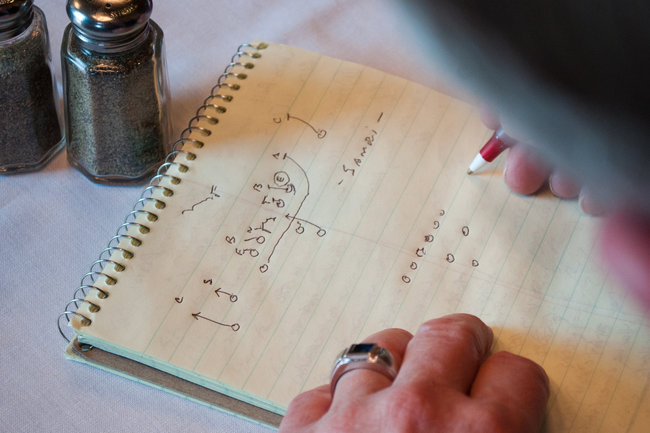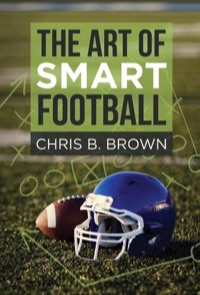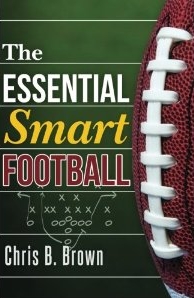Former Nevada coach and Pistol Offense auteur Chris Ault has been on a bit of a media blitz recently; check out interesting interviews he’s done with the New York Times and the NFL Network. And in his interview with Mercury-News’ Jerry McDonald, Ault highlighted the fact that it’s myopic to think of this stuff as just the read and specifically the quarterback keep. Instead, what makes it all work — and potentially viable for the future in the NFL — is it’s just one piece of the puzzle but it actually bolsters the rest of what you do.
Q: Seems like common sense to take advantage of the athletic skills these quarterbacks have . . .
Ault: Absolutely. I’m not here to tell you that the 49ers should run the read 16, 17 times a game. You can’t do that in the NFL. But I think by running the read play, it’s in your offensive system and you’re going to run it five times, nine times a game, it’s one more thing you’ve got to defend. And then when you throw the play-action pass off it, that’s another thing. So it’s not just one dimension that you’ve got to look at, it’s a couple of things. You see Kaep run that 56-yard touchdown, and you say, great, that’s the read option. And it is great. But I think one of the things that set that up was a couple of the play-action passes out of the pistol.
Q: Atlanta saw to it that Russell Wilson did not carry the ball on the read option based on how they deployed their linebackers . . . Kapernick’s running on the read option can be taken away, correct? And in so doing, do you relinquish the middle?
Ault: That’s exactly right and that’s what happened in college. They would load the outside and take Kaep away, and that’s why it’s the read. You give the ball off. We really designed our pistol offense, where we want the running back to carry the football. That is first and foremost in our thinking. But all of a sudden, you just fall asleep, just like Green Bay, you’re handing it, and handing it and handing it, and he might’ve been able to pull it a couple of other times, but he waited until the right time. No question, they might just say, ‘We’re not going to let this Kaepernick run the ball.’ And we had that in college. Then, it gives you an opportunity to run the read and the play-action pass.
This was fairly prophetic by Ault, as Atlanta ended up trying to take away Kaepernick and in the process gave up over 125 yards and 3 touchdowns to Frank Gore and LaMichael James, as well as some big play-action passes. (Though not all of this was from the Pistol; LaMichael James’s touchdown came on the inverted veer.)
– One of the persistent myths repeated in the otherwise very good New York Times piece mentioned above is that Chip Kelly ran the pistol at Oregon. This is, as I’ve mentioned before, incorrect, as Chip himself has explained:
Q. One of the recent trends in the NFL is more pistol formation. People are tracing that back to you. Your thoughts on what seems to be a melding of the NFL and college games.
COACH KELLY: Don’t know. Haven’t been there. Don’t run the pistol offense. That’s not what we do.
Chris Ault at Nevada invented the pistol offense. Just retired. Great football coach out there. There’s a lot of ways to play football. Pistol, don’t know that very well. We’re more of a spread run team.
Trends go one way and the other. I said this a long time ago, if you weren’t in the room with Amos Alonzo Stagg and Knute Rockne when they invented this game, you stole it from somebody else. Any coach is going to learn from other people and see how they can implement it in their system. Anything you do has to be personnel driven. You have to adapt to the personnel you have. There’s a lot of great offenses out there, but does it fit with the personnel you have? The key is making sure what you’re doing is giving your people a chance to be successful.
– As Chip observes, whether or not these kinds of schemes will be sustainable in the NFL will depend in a large degree on personnel — the supply of multi-talented quarterbacks. As Matt Hinton points out, while this year’s NFL draft class has few true dual threat candidates (and few quarterback candidates to get very excited about at all, though there are some potential sleepers), there is another wave of dual threat guys working their way up through the college ranks right now.
– Bill Barnwell on Matt Ryan and Tom Brady.
– A battle for the best skit from the Chappelle show.
– “You have CTE.” Scary stuff.
– Tim Layden on sportswriting after the Te’o mess.
– Vic Koenning, on the effect of the NFL playoffs on perception of what college defensive coordinators are up against:
“Look at the NFL scores from last week’s playoff games,” Koenning said on the InsideCarolina.com radio show. “That will wake everybody up to what us college defensive coaches have been facing for the last few years now.”
“If (offensive coordinators) know what you are in, they have answers to stuff,” Koenning said. “The old days of lining up in the I formation and saying our Jimmys are better than your Joeys, and we want to beat you into submission, nobody wants to do that anymore. Everything is about space. If you have guys that can’t compete in space then you’re going to be struggling.”
He also noted that the traditional 4-3 look might not be built to keep up, meaning more of a move to a 3-4 or some kind of hybrid look (as North Carolina uses). Indeed, it’s worth noting that both teams in the Super Bowl are base 3-4 teams (though they use lots of fronts.)
“I am not saying that teams that play a traditional 4-3 can’t be successful, but I will tell you that it puts stresses on a lot of different positions with what today’s college football offensively has become,” he said. “I kind of think it forces you to look at what you have personnel-wise and scheme-wise.”
– Gear up: Make sure to keep checking the Smart Football store, as I will be adding new stuff over the coming days.








